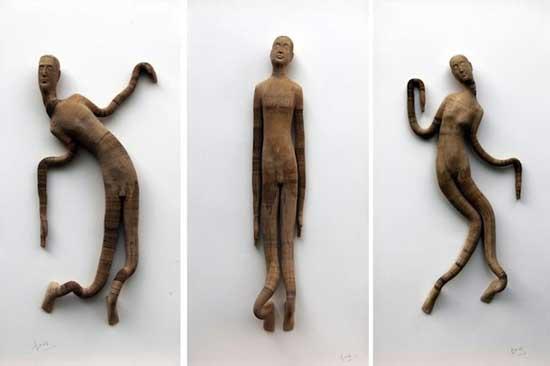

38-year-old Chinese artist places his hands on one, lifts gently, and what had seemed like solid plaster transforms into a live, amorphous mass. A Roman soldier stretches like elastic, a pretty English maid suddenly rises like a terrible phantasm. They are neither plaster nor clay, but concertinas of thousands of fine pieces of paper.
38-year-old Chinese artist has transformed an ancient art form using an equally old but unexpected medium.
The line of pure white busts sitting amongst the dust in Li Hongbo's Beijing studio could be found in any art classroom around the world. That is until the 38-year-old Chinese artist places his hands on one, lifts gently, and what had seemed like solid plaster transforms into a live, amorphous mass. A Roman soldier stretches like elastic, a pretty English maid suddenly rises like a terrible phantasm. They are neither plaster nor clay, but concertinas of thousands of fine pieces of paper.
"At the beginning, I discovered the flexible nature of paper through Chinese paper toys and paper lanterns. Later, I used this to make a gun. A gun is solid, used for killing, but I turned it into a tool for play or for decoration. In this way, it lost both the form of a gun, and the culture inherent to a gun. It became a game." Li said.
Li says he has always loved paper, first invented in ancient China. He has spent six years producing a collection of books recording more than 1,000 years of Buddhist art on paper. In his recent works, Li has consciously produced only perfect replicas of classical busts and shapes he used to sketch at university. The denatured human forms may make some squirm, but Li says he uses the archetypal figures to make audiences concentrate on the material, not to shock.
"'Strange' and 'unsettling' are just adjectives used by some individuals. In fact, people have a fixed understanding of what a human is, and think that a human cannot be physically manipulated, so when you transform a person, people will reconsider the nature of objects and the motivation behind the creation. This is what I care about." Li said.
His exhibition "Tools of Study" at the Klein Sun gallery in New York has earned him plenty of attention across the Pacific since it opened on January 9th. Gallery assistants pull the twenty pieces around on their plinths for visitors, but not being allowed to touch pieces themselves leaves some feeling unfulfilled.
"You know, when you can open it, there's movement, there's mobility, it becomes a dynamic thing versus a very static thing. You know, but it's like, of course, as an observer, it's like, I can only enjoy that momentum or that movement of the object if someone opens it for me. It's so funny, because it's like, enticing. You kind of want to play with it but you can't." Visitor Lydia Chrisman said.
Li is aware of this problem, and at a show in Sydney he provided small models for the audience to play with. Though he refused to disclose prices, growing demand for his works means the cost of a real one would probably stretch your wallet.
Copyright ©1999-2018
Chinanews.com. All rights reserved.
Reproduction in whole or in part without permission is prohibited.